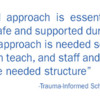As schools across the US start the new school year and welcome students back, whether online or in-person, many continue to adapt to the challenges and uncertainty created by COVID-19. Many students going back to in-person learning are adapting to the difficulties that come with entering a classroom for the first time in over a year, and many students continuing distance learning are adapting to being away from their sources of support and resiliency (e.g. classmates, activities, adult mentors). For students who have experienced trauma, the new school year can be even more challenging. Traumatic events can interfere considerably with a child’s learning and behavior at school. The continued uncertainty of how the pandemic will affect their daily routine is particularly disruptive to students who need consistency, structure, and safety to cope and heal. It is important for schools to recognize the impact that a student's personal experiences can have on their learning achievement and provide them with the support they need to achieve their educational goals. The NCTSN has resources to help support educators, school staff and administrators in providing trauma-informed care when working with students.
Trauma-Informed School Strategies During COVID-19
Offers information on the physical and emotional well-being of staff and creating a trauma-informed learning environment, including strategies for dealing with stress/STS for educators and administrators during COVID-19. It includes guidance for identifying, assessing, addressing, and treating traumatic stress. This fact sheet also provides trauma education and awareness, partnerships with students and families, cultural responsiveness, emergency management and crisis response, and school discipline policies and practices.
Child Trauma Toolkit for Educators
Provides school administrators, teachers, staff, and concerned parents with basic information about working with children who have experienced trauma in the school system. This includes a Self Care for Educators tip sheet.
Trauma-Informed Schools for Children in K-12: A System Framework
Highlights the key elements of the 2017 NCTSN System Framework for Trauma-Informed Schools, while also underscoring the public health implications of trauma exposure and the benefits of having trauma-informed schools.
Supporting Schools to Test and Implement Tailored Trauma-Informed Practices
Highlights key components of the NCTSN Breakthrough Series Collaborative (BSC) for Supporting Trauma-Informed Schools to Keep Students in the Classroom. The video series features the voices of school staff, administration, and NCTSN partners about how the BSC helped catalyze trauma-informed cultural change in schools to better support students, families, teachers, and administrators.
Childhood Traumatic Grief: Information for School Personnel
Offers information on why school personnel are important for grieving students. This fact sheet outlines how children grieve, what Childhood Traumatic Grief is, who develops Childhood Traumatic Grief, what traumatic stress reactions in Childhood Traumatic Grief can look like, the signs a student might have Childhood Traumatic Grief, and what school personnel can do to help their students.
Addressing Race and Trauma in the Classroom: A Resource for Educators
Helps educators understand how they might address the interplay of race and trauma and its effects on students in the classroom. The guide outlines recommendations for educators and offers a list of supplemental resources. It should be implemented in accordance with individual school policies and procedures.
Pause-Reset-Nourish (PRN)* to Promote Wellbeing: Use as Needed to Care for Your Wellness!
Provides information about the specific self-care strategy of Pause-Reset-Nourish, or PRN. This fact sheet acknowledges the levels of stress that professionals may be currently experiencing and offers a way to address unwanted symptoms and promote and replenish wellbeing and enhance resilience.
Taking Care of Yourself
Offers providers a list of ideas for self-care strategies to use after a difficult event. This checklist outlines the three basics aspects of self-care including awareness, balance, and connection.






Comments (0)